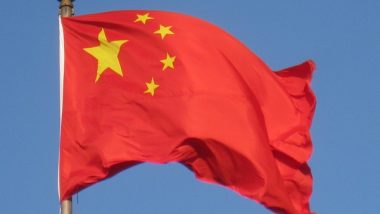Beijing [China], September 23 (ANI): China’s approach regarding water with lower riparian countries in South and South-East Asia, includes territory grabbing water resource hegemony, resulting in a threat to all the countries in the region, a report by The Daily Asian Age stated.
The report in Bangladesh-based daily further highlighted that Chinese investments in water-based resources is leading to adverse impact on the environment, displacement of local people and huge debt to countries.
Also Read | New India-EU Trade Route: Bringing the Gulf States Closer?.
The combination of territory grabbing and water resource hegemony by China is a threat that all countries in South and South East Asia face and their respective security environments
Although, the planet is covered with 70 per cent water, but only 2.5 per cent of this is fresh water, which has led to many experts predicting the next theatre of war as the conflict over water.
Also Read | AI: Help or Hindrance in Fight Against Disinformation?.
This is precisely why nations have begun to preserve fresh water and, in some cases, have gone beyond to become global water hegemons, as they grow and develop. One example in the list is China.
Being a water-stressed country, Beijing made huge investments in water-based resources globally.
However, apart from the geo-political implications, China’s water hegemony has had an adverse impact on the environment, and well-being of local populations and pushed nations into debt traps due to resource-intensive investments in dam/hydroelectric projects.
According to the Daily Asian Age report, China is said to have constructed a whopping 308 dams in 70 countries on various rivers (Tibet Policy Institute, September 23, 2016).
The recent estimates of China’s dam construction worldwide show that these dams generate a total of 81 GW of power. Such indiscriminate dam construction has adversely affected river courses, caused environmental degradation and resulted in floods and displacement of thousands of people living in the host nations and further downstream, the report added.
China’s disregard for environmental conservation and consistent denials of the ecological fallouts of its mega projects on the Tibetan plateau has further aggravated global concerns. China’s disregard was most telling in the construction of the Three Gorges Dam. The estimates show that between 1992 and 2008, over 1.5 million residents living in the floodplains of the Three Gorges Dam were displaced, Daily Asian Age reported.
Notably, China’s territory is the starting point for major rivers that flow into more than a dozen other countries, making it Asia’s “upstream controller” and giving it unmatched power to “weaponise water” against downstream countries.
As per the report, the development of overseas hydropower by China needs to be contextualised in these terms.
Six of Asia’s largest rivers, Brahmaputra, Indus, Salween, Irrawaddy, Mekong, and the Yangtse, have their origins in China. These rivers flow into as many as 18 countries, making China the upstream water hegemon. As an upper riparian state, China’s domestic demand has pushed it to dam its rivers with disastrous results for downstream nations, Daily Asian Age reported.
The report highlighted that China’s eleven dams on the Mekong have disrupted aquatic life and flow sediment and have directly contributed to the collapse of river banks. The Mekong dams have also triggered recurring droughts and caused floods in countries like Thailand and Laos.
It further cited a 2019 study by the Stimson Centre in the US, that shows that even though upstream Mekong received excess rainfall, China blocked the water in its dams, resulting in downstream countries facing unprecedented droughts. Satellite imagery showed that the lack of water in the lower Mekong was mainly due to blockage by dams in China (The International Prism, 22 January 2022).
The lack of real coordination among countries in the region for operating dams has allowed China’s eleven Mekong dams to disrupt aquatic life and flow sediment and has directly contributed to the collapse of river banks and the destruction of communities, Daily Asian Age reported.
Beijing has also consistently refused to engage in mutually beneficial and cooperative water-sharing arrangements across borders. Despite sharing over forty transboundary water sources, China has very few water governance treaties with its fourteen neighbours.
The report added that China avoids from entering into multilateral, basin-wide transboundary water agreements, lending credence to the assertion that China sees water resources as a sovereign rather than as a shared source.
“China’s approach to waters is governed by outright unilateralism and a maximalist approach to water sovereignty enabled by its rapid hydro-engineering prowess. This is one of the reasons for China not showing any willingness to share hydro data and sedimentary load data, with either the Mekong basin states or India, the two regions where China has asserted its upper riparian status with full gusto,” Daily Asian Age reported.
China has also attempted to exploit the Tibetan Autonomous Region (TAR), which contains a major portion of the world’s fresh water. The official figures reveal that by the end of 2017, installed hydropower capacity in China had reached 341 million kilowatts, while the installed hydropower capacity in the TAR was only 1.77 million kilowatts, accounting for only 1 per cent of the technically exploitable potential. (Hongzhou Zhang and Genevieve Donnellon-May, The Diplomat, 1 September 2021).
The downstream impact of such development is only too obvious. The inclusion of the Medog Dam (near the border with Arunachal Pradesh) in the 14th FYP was driven in part, by China’s push towards Carbon Emission reduction (Jagannath Panda, China Brief, Jamestown Foundation, June 7, 2021).
China aims to achieve carbon neutrality by 2060. As China shifts away from coal, which supplies nearly 70 per cent of its energy use, to clean energy sources like hydroelectricity, more dams can be expected to be built. (The Diplomat, 1 September 2021), according to Daily Asian Age.
The report added that a growing source of tension in the Himalayas is China’s plans to dam key rivers before they reach India. China has also taken recourse to blocking the flow of rivers. In June 2020, satellite imagery showed that China had used bulldozers to block the flow of the River Galwan, a tributary of the Indus River in Aksai Chin, thus preventing it from flowing into India.
China’s proposed Medog Dam, close to the border with Arunachal Pradesh, will eventually have an impact on lower riparian states, particularly India and Bangladesh.
The report further stated that the ongoing diversion of substantial volumes of water from the Tibetan plateau watershed by China for northern China could strain India’s agricultural needs in the Northeastern states; conversely, Chinese mismanagement could lead to overflows and floods in India. The threat of a water bomb being unleashed on India from the proposed Medog dam cannot be overlooked
In 2000, a Tibetan dam burst resulting in massive flooding in India. (Jagannath Panda, Jamestown Foundation, 7 June 2021). In March 2021, a change in flow rate, turbidity and quality of the Yarlung Tsangpo River water was observed. This was attributed to the massive landslide and glacial surge near the Great Bend Region. Landslides in the Great Bend Area of the River in Jialacun Village, Tibet have the potential to cause flooding towards India (Arunachal Pradesh), Daily Asian Age reported.
Meanwhile, China’s motives in investing in hydropower overseas is clearly a ‘neo-colonial’ drive to capture resources and materials, both as a part of the Belt and Road Initiative and otherwise to fund China’s GDP growth at the cost of other nations.
Chinese investment in power projects globally in the past two decades is estimated to be USD 114 billion, 44 per cent of which went to hydropower. Further, Chinese companies reportedly hold an estimated 70 per cent of the global hydropower market. (International Institute for Environment and Development News, 17 March 2022). This gives us a sense of China’s ambitions and its desire to control resources wherever possible.
The report cited Brahma Chellaney, one of India’s foremost experts on water, who aptly stated, “China’s territorial aggrandizement in the South China Sea and the Himalayas…. has been accompanied by stealthier efforts to appropriate water resources in transnational river basins.”
There is merit in reviewing India’s position on water security from this perspective and planning for the future. The combination of territory grabbing and water resource hegemony by China is a threat that all countries in South and South East Asia face and their respective security environments, Daily Asian Age reported. (ANI)
(This is an unedited and auto-generated story from Syndicated News feed, LatestLY Staff may not have modified or edited the content body)













 Quickly
Quickly

















